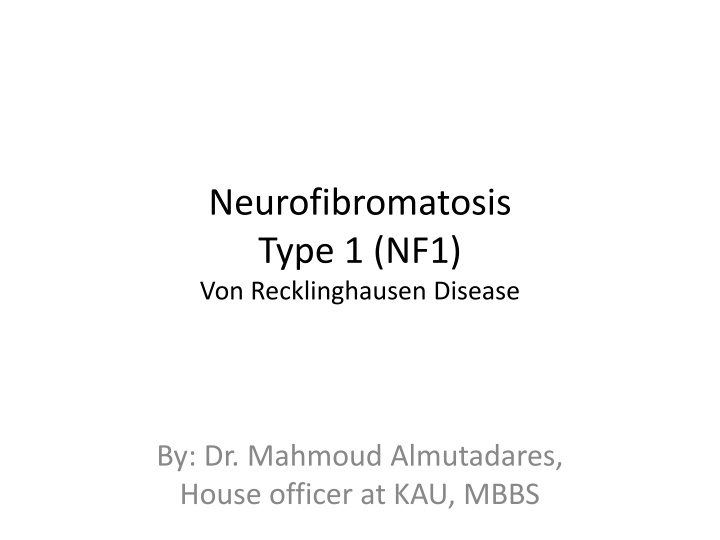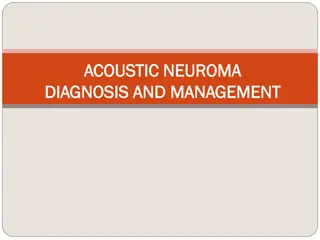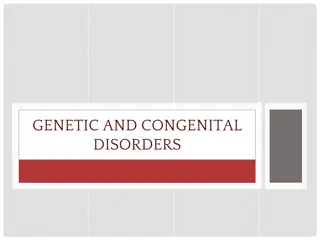Neurofibromatosis
Neurofibromatosis Type 1 (NF1), also known as Von Recklinghausen Disease, is a genetic disorder characterized by neurofibromas, Café-au-lait spots, and other clinical features. The condition is caused by mutations in the NF1 gene located on chromosome 17. This article explores the epidemiology, molecular basis, and clinical manifestations of NF1, including key information on neurofibromin, modifier genes, and distinctive osseous lesions associated with the disorder.
Download Presentation

Please find below an Image/Link to download the presentation.
The content on the website is provided AS IS for your information and personal use only. It may not be sold, licensed, or shared on other websites without obtaining consent from the author.If you encounter any issues during the download, it is possible that the publisher has removed the file from their server.
You are allowed to download the files provided on this website for personal or commercial use, subject to the condition that they are used lawfully. All files are the property of their respective owners.
The content on the website is provided AS IS for your information and personal use only. It may not be sold, licensed, or shared on other websites without obtaining consent from the author.
E N D
Presentation Transcript
Neurofibromatosis Type 1 (NF1) Von Recklinghausen Disease By: Dr. Mahmoud Almutadares, House officer at KAU, MBBS
Objectives Epidemiology of NF1 Neurofibromin gene Clinical features of NF1 Molecular basis of NF1 Gene strategies to identify modifier genes
Epidemiology Birth incidence: 1:2500 Prevalence of 1:4000 Autosomal Dominant with variable expression
Neurofibromin 1 Located in 17q11.2 Approximately 350kb and contains 61 exons A tumor suppressor gene. Encodes for Neurofibromin Over 300 different mutations reported worldwide
Clinical Features Short statured Caf -au-lait (CAL) spots Freckling Lisch Nodules Neurofibromas Optic gliomas
Caf-au-lait Freckles
Dermal Neurofibromas Plexiform Neurofibroma
Lisch Nodules Optic Glioma
Distinctive osseous lesion such as sphenoid dysplasia or cortical thinning of long bones
Expressivity Expressivity is the variations in a phenotype among individuals carrying a particular genotype, it is analogous to the severity of a condition in clinical medicine. Variable expressivity occurs when a phenotype is expressed to a different degree among individuals with the same genotype.
5-10% >90% Intragenic Mutations Large 17q11 deletions No clear-cut allele-phenotype correlations More sever phenotype 3-bp frame deletion (c.2970- 2972 del ATT) on exon 17 Absence of Dermal neurofibromas
1132 Individuals from 313 families No apparent influence of the NF1 gene
Cohort Family Studies 2nd 2nd 2nd 2nd 3rd 3rd 3rd 3rd MZ Twins Twins Twins Twins MZ MZ MZ Trial Trial Trial Trial Patients Patients Patients Patients Families Families Families Families Siblings Siblings Siblings Siblings Parent-offspring Parent-offspring Parent-offspring Parent-offspring degree degree degree degree degree degree degree degree Easton et al 1993 1993 1993 Easton et al Easton et al 175 175 175 48 48 48 6 6 6 76 76 76 60 60 60 54 54 54 43 43 43 Szudek et al 2000 2000 Szudek et al 904 904 373 373 ALL ALL Sabbagh et al 2009 275 ALL
75% of families have an interfamilial difference in clinical features NF1
p53 p53 NF1 NF1 p53 p53 NF1 NF1
NF1 expression level Nstr1 11q12-13 CH11 5p13-15 Nstr2 8q22-24
Gene strategies to identify modifier genes Approach scanning the whole genome Approach focusing on candidate genes Number of variants are generally small. However, detailed understanding of the candidate gene product.
Candidate gene approach 1. Generate hypothesis and identifying candidate genes: Understanding the biochemical function of NF1 2. Identifying variants (SNPs) near these genes 3. Genotyping these variants in a populations
MLH1 MSH6 PMS2 MSH2 > Dermal Neurofibroma
SKP NF1+/- Males and Non-Pregnant Females Pregnant Females
5% expressed estrogen receptors 75% expressed progesterone receptors NF1 patients typically develop dermal neurofibromas around puberty Increased potential for malignant transformation of plexiform neurofibromas with pregnancy
Whole genomic gene approach Pasmant et al CDKN2A-CDNK2B-ARF ANRIL Tag SNPs In 1105 subjects (306 families): Allele T of SNP rs2151280 was strongly associated with plexiform neurofibromas
Refrences Nelson Textbook of pediatric, 19th edition Oxford Handbook of Clinical Medicine, 8th edition Pasmant E, Vidaud M, Vidaud D, Wolkenstein P. Neurofibromatosis type 1: from genotype to phenotype. J Med Genet 2012;49:483-489 Heim RA, Silverman LM, Farber RA, Kam-Morgan LNW, Luce MC. Screening for truncated NF1 proteins. Nature Genet. 8: 218-219, 1994. Trovo-Marqui AB, Tajara EH. Neurofibromin: a general outlook. Clin. Genet. 70: 1-13, 2006.



